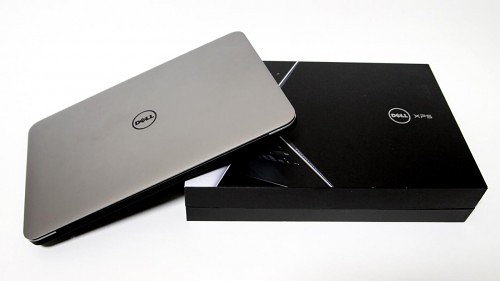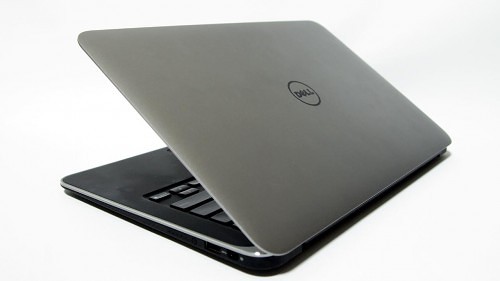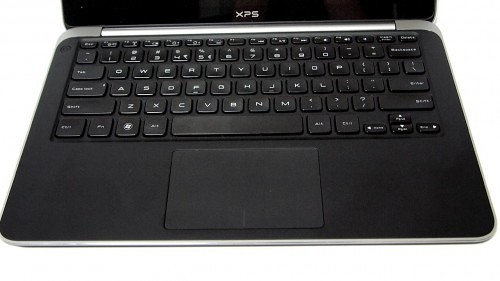
Thin and light is the name of the game. You no longer have to lug around a heavy laptop to get the full PC experience, thanks to the recent generation of Intel-powered ultrabooks. Today, we take a look at the Dell XPS 13 Ultrabook that slots right into that market. The silver anodized aluminum body immediately speaks to the higher quality of this ultrabook, but does this beauty really hide a beast under the hood? Let’s dive in and find out.
Product Overview

You might remember my review of the Dell XPS 15z a short while back and how I said Dell clearly borrowed some inspiration from the Apple MacBook Pro. Well, the Dell XPS 13 is much the same, except it is targeting more of the MacBook Air crowd.
As mentioned above, you get a silver anodized aluminum body in a remarkably thin frame. The underside is an almost rubbery carbon fiber, once again adding to the “premium” feel. Like other Ultrabooks, the XPS 13 does away with the typical optical drive in an effort to keep the weight low and the profile slim. You’ll also notice that the 47 WHr 6-cell battery is integrated into the notebook itself, adding to the svelte appearance. This version has a 13.3-inch 720p Truelife WLED display, though there is also the larger XPS 14 if you want a bigger screen.
Because it is an ultrabook, ports are minimal. There is a single USB 3.0 port on the right, along with a DisplayPort. On the left, you get a USB 2.0 port, a headphone/microphone combo jack, and the port for the power adapter.
Features and Specs as Tested
As with most other Dell products, the XPS 13 also comes in a range of SKUs with customizable specs. Current pricing starts at $999, but the model we are testing has been upgraded to a current price of $1499. With that premium, you get a second-generation Intel Core i7-2637M (1.70GHz with Turbo Boost 2.0 up to 2.80GHz) processor, 4GB of dual channel DDR3-1333 RAM, Intel HD Graphics 3000, and Windows 7 Home Premium 64-bit. The hard drive platter has been replaced by a 256GB solid state drive as well.
By comparison, the $999 model only gets a Core i5-2467N processor and 128GB solid state drive, though it retains the same graphics and the same RAM. The processor upgrade alone is $200.
Keyboard and Trackpad

The keyboard on the XPS 13 is wonderfully comfortable as far as notebook keyboards are concerned. The chiclet-style keys are well spaced and they provide just enough of a squishy-yet-clacky experience when it comes to key travel. While I would have personally preferred full-size keys for the four directional keys, I understand the aesthetic appeal of that the smaller keys provide.
Unlike the keyboards on some competitors, the Dell XPS 13 also has full-size shift keys on the left and the right. One of my most common complaints is the use of smaller shift keys in order to accommodate an additional key, but that tends to result in more typos. This layout is much more preferable.
While the XPS 15z still had dedicated mouse buttons below the trackpad, that’s not the case here. You get a single unified trackpad where a tap on the lower-right portion results in a right-click and a tap just about anywhere else is a left-click. The whole trackpad “clicks” inward, but a gentle non-clicking tap still works for left-clicking. It’s smooth, but with just enough texture for a better user experience. The soft finish for the palm rests is equally appealing.
Display and Viewing Angles
This seems to be a problem that plagues most, if not all Dell laptops. I saw this on the Dell Inspiron 14z, just as I saw it on the XPS 15z. The viewing angles on the XPS 13 are quite narrow, both on the horizontal plane and on the vertical plane.
Any deviation from the “sweet spot” would result in the characteristic “washing out” of details, rendering the screen image virtually unusable. This is true whether you’re looking top-down (as depicted above), bottom-up, or from either side. Yes, I understand that an ultrabook or a notebook is a largely personal experience, but a wider viewing angle would have certainly been appreciated for when you want to show something to a friend or colleague. It would even be useful when you want to curl up with a video yourself and you’re not quite in the dead-on sweet spot.
PCMark05 Benchmark
To test the performance of the XPS 13 ultrabook, we ran it through our usual battery of benchmarks starting with PCMark05 Professional Edition.
While it was not able to compute an overall PCMark score, the utility did calculate a CPU score of 7839, a memory score of 9231 and a graphics score of 5035. This puts it roughly on par with the Inspiron 14z and the XPS 15z that we had tested previously.
3DMark06 Benchmark
Most people aren’t going to use the Dell XPS 13 for heavy graphical lifting, but it is a little disappointing to seen an overall score in 3DMark06 Professional Edition of just 4173 3D Marks. While I was able to use this ultrabook for some casual video watching (including in full HD) and some minor photo editing, you can see how it would start to struggle with anything far beyond that.
The SM2.0, HDR/SM3.0, and CPU scores as measured by 3DMark were 1413, 1696, and 2874, respectively. In this way, while the XPS 13 is an easy notch above what you’d get out of a netbook, it’s not going to be much better from a graphical standpoint than many less expensive (albeit definitely bulkier) entry-level notebooks.
Street Fighter IV Benchmark
Given the results from the 3DMark Professional Edition benchmark, the results from the Street Fighter IV benchmark aren’t going to surprise anyone.
I initially left the SFIV benchmark at its default settings, aside from turning on the full screen. The default settings included a resolution of 1366×768, a refresh rate of 60, parallel rendering, default texture filter, high model quality, high background quality, low soft shadow, low self shadow, low motion blur, mid particles and no extra touch. With these settings, the XPS achieved an abysmal score of 6923 and an average of 24.16fps. That gets an “E” rank.
So, I tried turning down the settings significantly by turning all the qualities to low or off, where available, while retaining the same resolution. That still got a “D” rank with a score of 10240 and an average of 30.91fps. That’s still not good enough.
Taking things to an absolute extreme, I left the qualities to low or off and dialed down the resolution to a nearly prehistoric 640 x 480 (VGA). Remember that the quality settings are such that the characters have very little detail and the background is essentially a wireframe. It was only under these far from desirable settings that I got an “A” rank with an average 58.82fps. No one wants to play Street Fighter under those conditions.
PowerMark Battery Life Test
An ultrabook, given the lower draw processor and the inclusion of an SSD, should have a fairly impressive battery life. It’s meant to be a mobile workstation that doesn’t need to be constantly bound to a wall outlet.
To test the battery life, we used PowerMark Professional Edition. This benchmark allows for multiple scenarios to simulate real-world use. I opted for the “balanced test,” which “uses an even split between the web browsing, word processing, video and gaming workloads.” It opens browsers, it types documents and it otherwise mimics how a real person might use the notebook.
With these circumstances, PowerMark estimated a battery life under load of three hours and fifteen minutes. Remember that the MacBook Pro-like XPS15z got 3:01 in the same test. Given that, I’d say the battery life on the XPS 13 isn’t exactly up to snuff. It needs to last longer than that.
Day to Day Operations
If you plan on doing any sort of moderate to heavy graphical lifting, the XPS 13 certainly isn’t for you. It’s not meant to be a powerhouse and it never will be, mostly because it is still relying on Intel HD graphics. That said, the Core i7 processor and 4GB of RAM, along with the SSD, make this a rather peppy machine for basic day-to-day use.
Getting to the Windows 7 login screen from a cold boot takes about 14 seconds, which is reasonably fast. There is the FastAccess facial recognition software too, but I found typing in my password was much faster. Getting into programs, streaming video, and doing other casual tasks were all reasonably speedy too. As mentioned, the keyboard and multi-touch trackpad are comfortable, even after extended sessions.
I do appreciate the lack of glossy surfaces (aside from the display), because it means that you’re not constantly wiping away greasy fingerprints. This is certainly an attractive piece.
Closing Thoughts
Many people still think of Dell as that company that can sell you a cheap, but reasonably reliable laptop. Our household had the trusty 12-inch 700m for a number of years and it was a great little notebook. The problem with older Dells is that, well, they weren’t exactly the prettiest things to look at.
The Dell XPS 13 is different. Yes, it borrows a lot of inspiration from the MacBook Air, but that’s not necessarily a bad thing. The aluminum finish looks great and the softer carbon fiber finish on the bottom is even better. You won’t want to use this for anything too intense, but daily operations are quite good. I just wish the battery life was better.
Moving forward, though, it’s hard to justify spending $1,500 on the XPS 13 as spec’d. For that amount of money, you can get a much faster and more powerful laptop, albeit one that will be noticeably larger and heavier. The $999 entry-level model may be more appropriate, but you may find the 128GB SSD to be on the small side.
At the same time, it’s hard to say how much longer people are going to be interested in ultrabooks at all. The upcoming family of Microsoft Surface tablets just seem more compelling. The Pro version will give you all the ultrabook goodness, but with the added benefit of a touchscreen and a more compact form factor. In any case, it’s a good time to be a consumer. It means we have greater choice and that’s always a good thing.
Pros
- Aesthetically pleasing with aluminum and carbon fiber
- Very comfortable keyboard and trackpad
- Good performance for daily use
- Multiple configurations available, all with SSDs
Cons
- Only one USB 3.0 port
- Poor graphics performance
- Relatively short battery life
- $1499 model feels overpriced
- No built-in card reader
Overall Rating: 7.0 / 10.0
Help Us Improve Our Reviews By Leaving a Comment Below!
